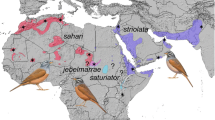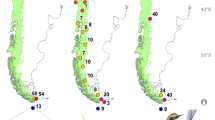Abstract
We describe two new bird species from the Meratus Mountains of southeastern Borneo, Indonesia: a jungle-flycatcher (genus Cyornis) and a white-eye (genus Zosterops). Our descriptions are based on comparisons of plumage, mitochondrial ND2 DNA sequences, and vocalizations of the new species and their congeners. The new Meratus jungle-flycatcher is most closely related to Cyornis montanus but morphologically distinguished by lighter blue on the upperparts and more whitish and less reddish on the underparts. The new Meratus white-eye is most closely related to Zosterops chloris but distinguished by olive upperparts and darker underparts. Vocalizations and genetic divergence values also corroborate species status for both new taxa. Both new species are probably confined to the Meratus Mountains, which are currently surrounded by degraded lower elevation secondary woodland or converted agricultural landscape. They appear to have diverged from their sister species through geographic isolation in this remote mountain range compounded by altered population dynamics in a depauperate montane bird community. Although both species are relatively common in the restricted area of the Meratus Mountains, continued habitat alteration and the imminent threat of poaching may be in the process of endangering them. Therefore, we recommend the IUCN Red List status of “Vulnerable” for the new species based on criteria B1 and B2.
Zusammenfassung
Beschreibung von zwei neuen Vogelarten von den Meratus-Bergen in Südost-Borneo (Indonesien)
Wir beschreiben zwei neue Vogelarten von den Meratus-Bergen in Südost-Borneo (Indonesien): einen Fliegenschnäpper (Gattung Cyornis) und einen Brillenvogel (Gattung Zosterops). Unsere Beschreibungen beruhen auf Vergleichen von Gefieder, mitochondrialen DNA-Sequenzen des ND2-Gens und Vokalisationen der zwei neuen Arten und ihrer Gattungsangehörigen. Der neue Meratus-Fliegenschnäpper ist am nächsten mit Cyornis montanus verwandt, unterscheidet sich jedoch morphologisch durch helleres Blau auf der Oberseite und durch mehr Weiß und weniger Rot auf der Unterseite. Der neue Meratus-Brillenvogel ist am nächsten mit Zosterops chloris verwandt, unterscheidet sich aber durch seine olivfarbene Oberseite und dunklere Unterseite. Vokalisationen und genetische Divergenzwerte bestätigen ebenso den Artstatus beider neuer Taxa. Beide Arten sind wahrscheinlich auf die Meratus-Berge beschränkt, welche heutzutage von gestörtem Sekundärwald auf niedrigeren Höhen oder von in landwirtschaftliche Flächen umgewandelten Landschaften umgeben sind. Beide Arten scheinen sich von ihren Geschwisterarten durch geographische Isolation auf dieser abgelegenen Bergkette abgespaltet zu haben, was durch eine veränderte Populationsdynamik in einer verarmten Bergvogelgemeinschaft verstärkt worden sein mag. Obgleich beide Arten in der beschränkten Gegend der Meratus-Berge relativ häufig sind, sind sie wahrscheinlich durch anhaltende Habitatsveränderungen und die unmittelbar bervostehende Bedrohung durch illegalen Vogelfang in Gefahr. Wir schlagen daher vor, die neuen Arten unter den Kriterien B1 und B2 der Roten Liste der IUCN als „gefährdet“ zu führen.














Similar content being viewed by others
References
Araya-Salas M, Smith-Vidaurre G (2017) warbleR: An r package to streamline analysis of animal acoustic signals. Methods Ecol Evol 8:184–191. https://doi.org/10.1111/2041-210X.12624
BirdLife International (2021) Important bird areas factsheet: Meratus Hulu. Downloaded from http://www.birdlife.org on 05/06/2021
Center For Conservation Bioacoustics (2016) Raven Lite: interactive sound analysis software (version 2.0.1). Cornell Lab of Ornithology, Ithaca
Davison GWH (1997) Bird observations in the Muratus Mountains, Kalimantan Selatan. Kukila 9:114–121
Eaton JA, Shepherd CR, Rheindt FE, Harris JBC, van Balen S, Wilcove DS, Collar NJ (2015) Trade-driven extinctions and near-extinctions of avian taxa in Sundaic Indonesia. Forktail 31:1–12
Eaton JA, Mitchell SL, Bocos CNG, Rheindt FE (2016a) A short survey of the Meratus Mountains, South Kalimantan province, Indonesia: two undescribed avian species discovered. BirdingASIA 26:107–113
Eaton JA, van Balen B, Brickle NW, Rheindt FE (2016b) Birds of the Indonesian Archipelago, Greater Sundas, and Wallacea, 1st edn. Lynx Edicions, Barcelona
Eaton JA, van Balen B, Brickle NW, Rheindt FE (2021) Birds of the Indonesian Archipelago, Greater Sundas, and Wallacea, 2nd edn. Lynx Edicions, Barcelona
Eck S, Töpfer T, Fiebig J, Heynen I, Fiedler W, Nicolai B, van den Elzen R, Winkler R, Woog F (2011) Measuring birds. Christ Media Natur, Minden
Gathorne-Hardy FJ, Syaukani DRG, Eggleton P, Jones DT (2002) Quaternary rainforest refugia in south-east Asia: using termites (Isoptera) as indicators. Biol J Lin Soc 75:453–466
Gill F, Donsker D, Rasmussen P (Eds) (2021) IOC World Bird List (v 11.2). https://doi.org/10.14344/IOC.ML.11.2. http://www.worldbirdnames.org/
Gwee CY, Eaton JA, Garg KM, Alström P, Van Balen S, Hutchinson RO, Prawiradilaga DM, Le MH, Rheindt FE (2019) Cryptic diversity in Cyornis (Aves: Muscicapidae) jungle-flycatchers flagged by simple bioacoustic approaches. Zool J Linn Soc 186:725–741
Gwee CY, Garg KM, Chattopadhyay B, Sadanandan KR, Prawiradilaga DM, Irestedt M, Lei F, Bloch LM, Lee JGH, Irham M, Haryoko T, Soh CKS, Peh KSH, Rowe KMC, Ferasy TR, Wu S, Wogan GOU, Bowie RCK, Rheindt FE (2020) Phylogenomics of white-eyes, a ‘great speciator’, reveals Indonesian archipealgo as the center of lineage diversity. Elife 9:e62765. https://doi.org/10.7554/eLife.62765
Iqbal M, Yustian I, Setiawan A, Setiawan D (2018) Ongoing slaughter of Eyebrowed Thrush Turdus obscurus in Sumatra: another species heading for oblivion? BirdingASIA 30:16–20
IUCN Standards and Petitions Committee (2019) Guidelines for using the IUCN red list categories and criteria. Version 14. Prepared by the Standards and Petitions Committee
Lim BTM, Sadanandan KR, Dingle C, Leung YY, Prawiradilaga DM, Irham M, Ashari H, Lee JGH, Rheindt FE (2019) Molecular evidence suggests radical revision of species limits in the great speciator white-eye genus Zosterops. J Ornithol 160:1–16
Mayr E (1996) What is a species, and what is not. Philos Sci 63:262–277
Mayr E (2000) The biological species concept. In: Wheeler QD, Platnick N (eds) Species concepts and phylogenetic theory. Columbia University Press, New York, pp 17–2
Mayr E, Ashlock PD (1991) Principles of systematic zoology, 2nd edn. Mc-Graw Hill, Inc., New York
Miller MA, Pfeiffer W, Schwarz T (2010) Creating the CIPRES Science Gateway for inference of large phylogenetic trees. In: Proceedings of the gateway computing environments workshop (GCE), 14 Nov. 2010, New Orleans, pp 1–8
O’Connell DP, Kelly DJ, Lawless N, O’Brien K, Marcaigh FÓ, Karya A, Analuddin K, Marples NM (2019) A sympatric pair of undescribed white-eye species (Aves: Zosteropidae: Zosterops) with different origins. Zool J Linn Soc 186:701–724
Oksanen J, Kindt R, Legendre P, O’Hara B, Stevens MHH, Oksanen MJ, Suggests MASS (2007) The vegan package. Community Ecol Package 10(631–637):719
Quek SP, Davies SJ, Ashton PS, Itino T, Pierce NE (2007) The geography of diversification in mutualistic ants: a gene’s-eye view into the Neogene history of Sundaland rain forests. Mol Ecol 16:2045–2062
Raes N, Roos MC, Slik JWF, Van Loon EE, Ht S (2009) Botanical richness and endemicity patterns of Borneo derived from species distribution models. Ecography 32:180–192
Rheindt FE, Prawiradilaga DM, Ashari H, Gwee CY, Lee GWX, Wu MY, Ng NSR (2020) A lost world in Wallacea: description of a montane archipelagic avifauna. Science 367:167–170
Shakya SB, Haryoko T, Burner RC, Prawiradilaga DM, Sheldon FH (2018) Preliminary assessment of community composition and phylogeographic relationships of the birds of the Meratus Mountains, southeastern Borneo, Indonesia. Bull Br Ornithol Club 138:45–66
Shakya SB, Irham M, Brady ML, Haryoko T, Fitriana YS, Johnson O, Rahman MA, Robi NJ, Moyle RG, Prawiradilaga DM, Sheldon FH (2020) Observations on the relationships of some Sundaic passerine taxa (Aves: Passeriformes) previously unavailable for molecular phylogenetic study. J Ornithol 161:651–664. https://doi.org/10.1007/s10336-020-01766-9
Smithe F (1975) Naturalist’s color guide. American Museum of Natural History, New York
Stamatakis A (2014) RAxML version 8: a tool for phylogenetic analysis and post-analysis for large phylogenetic trees. Bioinformatics 30:1312–1313
Vellinga WP, Planqué R (2015) The xeno-canto collection and its relation to sound recognition and classification. In CLEF (Working Notes)
Winker K (1998) Suggestions for measuring external characters of birds. Ornitologia Neotropical 9:23–30
WWF and IUCN (1995) Centres of plant diversity: a guide and strategy for their conservation. Volume 2. Asia, Australasia and the Pacific. The Worldwide Fund for Nature (WWF) and the IUCN-The World Conservation Union, Gland, Switzerland
Acknowledgements
We thank the State Ministry of Research and Technology (RISTEK research license numbers 388/SIP/FRP/E5/ Dit.KI/XI/2016 and 389/SIP/FRP/E5/Dit.KI/XI/2016) and the Ministry of Environment and Forestry for permission to undertake research in South Kalimantan. We also thank the Research Center for Biology, Indonesian Institute of Sciences (RCB-LIPI), Lindsay Burner, and the people of Kadayang village for much assistance in the field. The project protocol was approved by LSU’s Institutional Animal Care and Use Committee (#16-039). Financial support was provided by the US National Science Foundation Grant 1241059 and Louisiana State University Museum of Natural Science. We add our gratitude to Willem-Pier Vellinga and Bob Planqué, and the Xeno-Canto sound archive for hosting the sound recordings. MI acknowledges support from Indonesia Endowment Fund for Education, Ministry of Finance, the Republic of Indonesia (No. 20200622152245). Two anonymous reviewers deserve our thanks to improving the manuscript.
Author information
Authors and Affiliations
Corresponding author
Additional information
Communicated by A. Aleixo.
Publisher's Note
Springer Nature remains neutral with regard to jurisdictional claims in published maps and institutional affiliations.
Supplementary Information
Below is the link to the electronic supplementary material.
Rights and permissions
About this article
Cite this article
Irham, M., Haryoko, T., Shakya, S.B. et al. Description of two new bird species from the Meratus Mountains of southeast Borneo, Indonesia. J Ornithol 163, 575–588 (2022). https://doi.org/10.1007/s10336-021-01937-2
Received:
Revised:
Accepted:
Published:
Issue Date:
DOI: https://doi.org/10.1007/s10336-021-01937-2




